#oliver bulleid
Explore tagged Tumblr posts
Text
Bulleid's Proposed Locomotives
So it turns out Bulleid had so many of his designs dropped for one reason or another, and since I can't stick with a single project for more than a few seconds, I wrote up histories for all of them!
Enjoy the ramblings of a madman who spent a good long while finding free number slots for them.
Southern Railway Warship Class
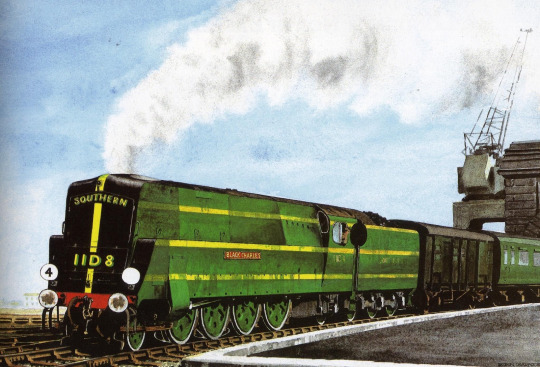
The Southern Railway was the most financially successful of the "Big Four", but this was largely based on investment in suburban and main line electrification. After the successful introduction of the SR Schools class in 1930, the railway had lagged behind the others in terms of modernizing its aging fleet of steam locomotives, as they were more focused on Electrification. Following the retirement of the general manager of the Southern Railway Sir Herbert Walker and Richard Maunsell the Chief Mechanical Engineer (CME) in 1937, their successors considered that the time had come to change this situation. In March 1938 the new general manager Gilbert Szlumper authorized Oliver Bulleid, Maunsell's replacement, to prepare designs for twenty express passenger locomotives. The deteriorating international situation prior to the Second World War was an additional factor in this decision.
Originally, Bulleid had wanted a 4-8-2 Mountain Type, but the Civil Engineering department had resisted this based on size and weight, so a 2-8-2 was chosen instead. Bulleid had worked with Gresley on his P2 2-8-2 express engines, so he already had some background knowledge, especially with the P2’s problems and ideas on how to solve them. Of course, due to the war, they were classified as heavy mixed-traffic engines to get around wartime regulations.
They were built with high-pressure 280 PSI boilers and three 18inx26in cylinders, as well as being the first engines to use Bulleid’s chain-driven valve gear, though the middle cylinder had to be inclined steeply to clear the first driven axle. The boiler was partly welded to save on cost, and the inner firebox was made of steel. The Southern had no facilities to build these boilers, so it was subcontracted to the North British Locomotive Co., as well as Beyer Peacock. They were also fitted with Bulleid’s Air-Smooth Casing. Unlike later designs that utilized this, the casing on the Warships both served their function purpose as labor saving as well as being able to be passed off as some sort of streamlining. How Bulleid got that one through during the war is a mystery! The Warship’s were also the first to use Bulleid’s Firth-Brown Wheels.
10 of these engines were constructed in 1940. More were set to be produced, but once again, the Civil Engineering Department expressed their discomfort at such a large engine running at high speeds with only a single pony-truck in front, despite other engines of a similar design getting on fine elsewhere. This would lead Bulleid to designing and building 30 of his well-known Merchant Navy Class 4-6-2s.
They were named after Warships as a way to increase morale, with 11D1 being officially named “Dreadnought” in April 1940. They performed well in service, hauling heavy passenger and express goods, though the Chain-Driven valve gear was sensitive and required high maintenance, as well as the oil-bath having leaking problems, contributing to wheel-slips(Though the extra wheel helped negate this as well). The casing, while it did save on labor during cleaning, and the more streamlined appearance helped with publicity, it made maintenance hard to carry out. Surprisingly, thanks to their different front ends, they never really experienced drifting smoke like Bulleid’s Pacifics.
All 10 of the engines would be passed into British Railways, numbered 37001-37010, where their duties mostly stayed the same. 11D8 “Black Charles'' took part in the 1948 locomotive exchange trials, where it was compared to LMS Duchess pacifics and LNER A4’s and A2/2s, where it performed favorably, though the chain driven valve gear and its oil bath still caused headaches. After the Crewkerne incident, BR chose a rebuilding program of any engines that still used Bulleid’s Chain Driven motion, however, as the Warships had required far less modifications that the Pacifics, they were on the bottom of the list in the rebuilding program. In the end, only 37003 “Triumph”, 37009 “Warspite”, and 37010 “Exeter” were rebuilt in 1956, 1957, and 1959.
Despite their status as a class with very few engines, all ten would survive until the end of southern steam, going between 1965-1966.
Two are preserved, both being rescued from Barry Scrapyard in Wales. These examples are Class Pioneer 11D1 “Dreadnought”, as well as 11D3 “Triumph”.
Stats
Power Classification - 8MT
Built - 1940 to 1941
Boiler Pressure - 280 PSI
Cylinders (3) - 18in x 26in
Wheels (Driven) - 6ft 2in
Wheels (Leading) - 3ft 1in
Wheels (Trailing) - 3ft 7in
Wheels (Tender) 3ft 7in
Tractive Effort - 40,640 lbf
Total Length - 74ft 8in
Fleet
11D1 (37001) - Dreadnought
11D2 (37002) - Anson
11D3 (37003) - Triumph
11D4 (37004) - Vanguard
11D5 (37005) - Ark Royal
11D6 (37006) - Audacity
11D7 (37007) - Valiant
11D8 (37008) - Black Charles
11D9 (37009) - Warspite
11D10 (37010) - Exeter
Southern Railway Prototype Light Pacific
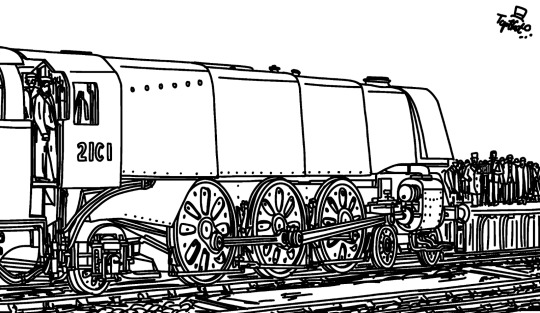
(Pic by Sttophat on twitter)
In 1941, Bulleid had introduced his Warship Mikado's and Merchant Navy Pacific's to become the main motive power for the Southern Railway’s Express passenger trains, though while they performed well, they were restricted by their weight, especially since the condition of the rails were hampered by the Second World War. Initially, trains on the lighter sections were handled by the Q1 0-6-0 freight engines and other, older engines, but they couldn’t handle the faster trains that were anticipated after the war. There was also the planned electrification of certain areas after the war, so the new design also needed to handle freight traffic as well, fast enough to not impede electric services.
What was decided on in the end was a downsized version of the Merchant Navy’s, fitted with the same design theory of the Q1’s to create a “Light Pacific”. The Locomotive was completed in 1942 alongside the Q1’s, and was trialed for a short time before entering service. It was deemed a success, and numbered 21C201. It was powerful enough to handle fast, heavy trains, as well as having an extremely light axle loading for a pacific at 16.5 Tons, enabling it to be used on almost every part of the UK Network as a whole. However, Bulleid decided to go with a different approach, creating simply a downsized Merchant Navy with no Q1 elements. This would increase the axle load, though this wasn’t much of an issue, as the Battle of Britain and West Country Class Light Pacifics still had a high enough route availability for the work they were assigned. Thus, the “Q1 Light Pacific'' would remain a one-off.
During the war, No.21C201 would actually travel a fair amount, and would regularly venture out of Southern territory, its light axle-load coming in handy. After the war however, it would mostly stay in the South. Performance-wise, it seemed to inherit all of the good qualities from the Q1’s and the pacific’s. The light-weight was already a plus, coupled with a great, free-steaming boiler and additions that made the driver and fireman’s life easier. However, it also inherited the bad aspects as well. The chain-driven valve gear was a well-known headache on bulleid locomotives, but there was also the issue that its light-weight caused. The regular Light Pacifics had trouble starting heavy trains thanks to their weight, but No.21C201 had it worse, especially with the well-known issues with the oil bath the valve gear was situated in. The light weight would also affect braking power as well, making unfitted trains harder to stop, a trait inherited from the Q1’s.
No.21C201 (Now Renumbered 34000) was not considered for rebuilding like the other Bulleid Pacifics due to its one-off status. It would be given a general repair in 1960 before spending the rest of its life at Nine-Elms, mainly working express and semi-fast goods trains and the occasional passenger turn during peak period and summer excursions. It was withdrawn from service in 1966 and broken up at Eastleigh.
Stats
Power Classification - 6MT
Built - 1942
Wheels (Driven) - 6ft 2in
Wheels (Leading) 3ft 1in
Wheels (Trailing) - 3ft 7in
Wheels (Tender) - 3ft 7in
Boiler Pressure - 250 psi
Cylinders (3) - 16.5in x 24in
Tractive Effort - 28,145lbf
Total Built - 1
Southern Railway L1 Class
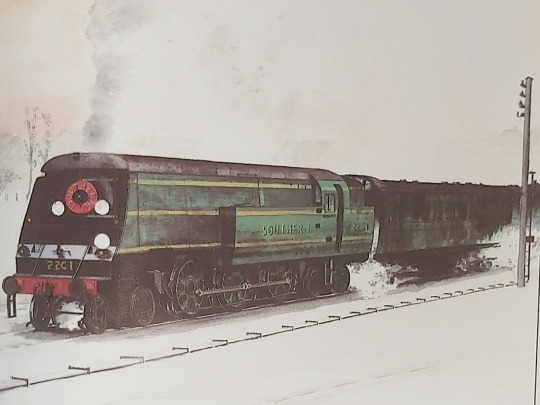
Bulleid designed these locomotives during the Second World War, but construction didn’t begin until 1946. They shared many components with Bulleid’s Q1 0-6-0 goods engines, and were essentially the Q1’s with an Air-Smoothed Casing and a bigger boiler (though the firebox was identical with that of a Q1’s).
Twelve of these engines would be constructed between 1946 and 1948, with the final 3 being built by British Railways. They were originally numbered 22C1 to 22C12, though they were renumbered in 1949 to 36101 to 36112. They were originally meant for short distance goods and passenger services, though they never really found their footing in this role. The passenger trains that usually necessitated big tank engines were already being handled by electric engines, and everything else usually required smaller and lighter engines, which meant that, despite inheriting the power and efficiency of the Q1, the added weight and size meant that they were barred from where they could be most effective. The goods work they were meant for were also in the care of both Q1’s and Maunsell’s Q Class, as well as the many N class moguls already in service. In the end they spent their time hopping from shed-to-shed before settling on ex-LSWR territory, and even venturing into Western Region territory.
They were withdrawn between 1962-1964. Only one survives, 22C9 (36109) on the Bluebell Railway.
Stats
Power Classification - 5F 4P
Built - 1946 to 1948
Boiler Pressure - 230 PSI
Cylinders (2) - 19in x 26in
Wheels (Driven) - 5ft 1in
Wheels (Bogies) - 3ft 1in
Tractive Effort - 30,080 lbf
Southern Railway Dock Class
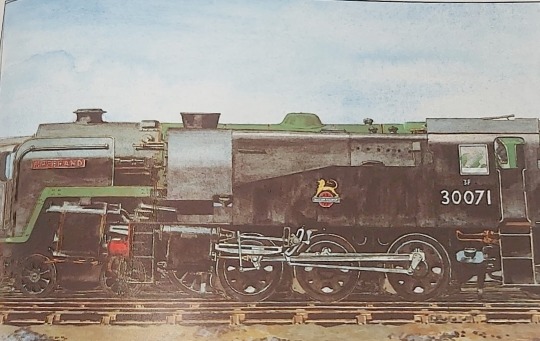
After the Second World War, many of the Southern Railway’s shunters (mainly those at Southampton) inherited from pre-grouping companies were worn out and needed overhauling. As such, Bulleid opted to replace them outright with his own design of 0-6-0T, with a short wheelbase of 10 feet to enable it to negotiate the tight curves. Like many of Bulleid’s designs, he equipped it with a relatively high boiler pressure.
Six would enter service in 1946, and while a total of 18 were planned, this would never come to be, as Eastleigh works was not in a position to build new locomotives with the backlog from the war. In the end, the southern found it cheaper to purchase ex-USATC S100 dock shunters, as they fulfilled most of the requirements needed.
They were numbered C201 to C206, and were renumbered to 30071 to 30076 in British Railways days. The first, 30071, was built with the Idaglass boiler lagging and casing as used in the Q1 class, while the other 5 were built with conventional boiler lagging and tanks. 30071 would be rebuilt like the others in 1953.
The class would lead uninteresting lives as dock shunters in Southampton and Dover until their withdrawal between 1961-1962. One was initially purchased for preservation but the deal fell through. None are preserved.
Stats
Power Classification - 3F
Built - 1946
Boiler Pressure - 220 PSI
Cylinders (2) - 16in x 24in
Wheels (Driven) - 4ft 6in
Tractive Effort - 21,276 lbf
#oliver bulleid#what-if engines#train#I have way more of these if you guys want to see them#or maybe I'll just do it anyways lol
54 notes
·
View notes
Text

Part 2 of the Steam Team's heights!
Douglas McIntosh-6' (182.9 cm)
Oliver Collett-6' (182.9 cm)
Emily Stirling-6' (182.9 cm)
Stanley Hudswell-Kitson-6' (182.9 cm)
Rosie Hill-Vulcan-6'1'' (185.4 cm)
Nia Vulcan-6'2'' (188 cm)
Rebecca Bulleid-6'3'' (190.5 cm)
Ashima Nilgiri-6'2'' (188 cm)
#thomas and friends#ttte human au#ttte douglas#douglas mcintosh#ttte oliver#oliver collett#height comparison#ttte emily#emily stirling#ttte stanley#stanley hudswell-kitson#ttte rosie#rosie hill-vulcan#ttte nia#nia vulcan#ttte rebecca#rebecca bulleid#ttte ashima#ashima nilgiri
6 notes
·
View notes
Text
Traintober 2024 Day 30: Oncoming Storm
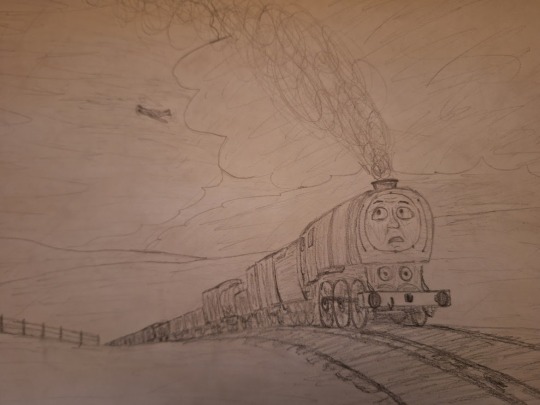
1943
Storm clouds swirled and darkened the sky, as an engine and its train puffed slowly through the English countryside.
The engine was a strange, boxy sort. One of Oliver Bulleid’s Q1 goods engines built with austerity in mind.
Despite being barely a year old, wartime service had taken a toll on him. His matte black paint, hardly a handsome look even when new, was covered in soot and grime, and a hoarse, tired panting sound emerged from his funnel.
The rain pelted down, and a distant roar of thunder shook the air.
The engine shuddered, and glanced nervously up at the angry sky.
Air-raids were an ever-present danger, which might loom behind every cloud.
"But surely..." the engine thought, "No aircraft, friend or enemy, would dare to fly in this stuff".
So despite the weather, he almost allowed himself to feel relieved.
At least there would be nothing more than rain.
That relief was soon gone however.
A chill ran through the engine's boiler, as through the storm the unmistakable drone of an aircraft rumbled overhead.
Its yellow nose emerged from the clouds, followed by a sinister gray body.
The black crosses on its wings boldly marked it an agent of death.
The engine saw it circle overhead, buffeted by wind and rain as it did so.
Slowly, painfully slowly, like a predator stalking its prey, it turned.
Then, it dipped its wings and dived towards the train.
The engine roared in fright, smoke poured from his funnel as he dragged the heavy train faster and faster.
He wanted to break the couplings all together, drop the train and run. But the couplings held, the rails curved up a steep hill, and his escape was painfully slow.
The aircraft's guns pointed out from its yellow nose, its sights aimed directly at the fleeing engine.
With great relief the engine crested the top of the hill.
The trucks, equally terrified at the prospect of being left behind, pushed forward, and with their surging weight the train rocketed down the hill, just as the aircraft guns flashed into life.
The crew ducked for cover as tracers blazed past their engine's boiler, burying into the ground and ricocheting off the rails.
Too close, Too Close, TOO CLOSE!
The engine whistled in terror as the winged beast zoomed overhead.
He could only watch, horrified, as it pulled up into a climbing turn, readying itself for another shot.
It was like it was toying with him.
Whistling fit to bust, the train raced down the line. Green fields gave way to houses, and air-raid sirens blared as the nearby town awoke to the ongoing attack.
The engine screamed through the station, feeling little relief even as searchlights and flak burst pierced the stormy sky.
The plane flew doggedly on, dodging ground-fire with almost unnatural swiftness and ease.
Diving in for another pass, it fired again. Metal punctured and tore, and the engine yelped as red hot pain reverberated through his side.
Cold wind blew through the newly opened gaps in his boiler cladding, and steam hissed from the bullet holes piercing his cylinder block.
He desperately tried to fight the pain and keep going. But his vision blurred, and his speed grew slower and slower.
He was a sitting duck.
Again the aircraft rose up, climbing and turning into position for what would surely be the final time.
The engine watched as the plane flew in towards him again, head on.
Its yellow nose grew larger and larger, the cannon mounted in its center bloomed as a black flower of death.
For both machines, the world narrowed into that single weapon.
The aircraft had just put its sights on target, when a searchlight beamed directly onto it.
It fired blindly, only barely missing its mark, as the dazzling light was followed by a flak burst striking clean into its cockpit.
The aircraft shook violently from the impact. Blood and oil sprayed out into its prop-wash, trailing behind in a fine mist which fell down over its would-be victim as it roared mere feet overhead.
Out of control, its dead pilot's hands limp on the stick, the wounded bird slowly pulled away into an unsteady climb.
Searchlights and ground-fire pursued it all the while, until it disappeared back into the storm clouds, and in a flash of lightning it vanished from the world of the living.
The rain continued to pour down, as back on the ground the engine and its train wheezed slowly to a halt.
His crew jumped down from the cab to inspect the damage, as he groaned and cried through escaping steam.
As the engine faded in and out of consciousness, fighting exhaustion and pain, he could only barely register that he was somehow still alive.
#ttte#rws#thomas the tank engine#the railway series#ttte art#ttte fic#ttte neville#ttte traintober#traintober 2024#traintober#tw: war#tw: guns#tw: violence#tw: mentions of blood#tw: mentions of death
23 notes
·
View notes
Text
Another batch of Gijinkas ^^

Truro "City of Truro" West
Age: 49
Height: 188cm
Head of the famous West family and owner of the steam engine City of Truro, which he purchased due to being a rich railway entusiast and their aligning names. Truro became a nationwide icon for everything Great Western and is basically worshipped by everyone of that background such as Duck. Despite being in a very influential position, he is quite modest and laid-back, being completely unbothered when having conversations with the "common people". The Wests have a years long rivalry with the Gresleys and so everyone expected that Truro would be mortal enemies with the current head of the Gresleys, Scott but unbeknownst to everyone, the two became secret lovers.

Dennis Bulleid
Age: 21
Height: 193 cm
Norman's older fraternal twin brother and the former biggest slacker you will ever meet. Dennis never took anything serious and always only did the bare minimum, avoiding all extra form of work where he could. His lazy attitude shined a bad light on the public for the Bulleids and after an incident he caused, he and Norman were disowned by their parents. Norman, in a rage, cut ties with Dennis and left him all by his own. It served as a wake up call for Dennis and is currently working to find a path for himself and a way to make up with his family, especially Norman, who he dragged down with him.

Marion Huber
Age: 26
Height: 167 cm
A happy-go-lucky construction worker, operating a steam shovel. She is always eager to get to work and do a good job, going into them with a playful approach. She has a lot of good luck regarding findings like dinosaur bones. Marion gets easily distracted or can be quite oblivious to thinks going on around her like not realizing that Oliver Armstrong the engine driver and Oliver from the Pack were two different people or taking Bert, Rex and Mike's methaphors literal.

Sutton "Splatter" Derby and Doug "Dodge" Derby
Age: 50
Height: 183 cm
Diesel 10's personal henchmen, working for him ever since he took on his position as mafia boss. They follow all of his orders but tend to question a lot of deciasions but would not go further do to their fear of D10. They prefer to complain and gossip behind everbody's back like over the fact being called "Splodge" by their boss and are quite cowadly, yet they can still be very cruel and no atrocity goes too far for them. Unlike Arry and Bert, these two have no attachment to Diesel and actually look forward to punishing him for turning on them.

Glynn Wrightson
Age: 68 (at disappearence)
Height: 170 cm
An engineer that lived a long time ago. He helped constructing the so called coffeepot engines and assisted in the foundation of british railway. One day he disappeared without a trace in a very similar way to Hiro and was found on present day Sodor by Marion. The kind elderly man now lives on the island, working for Ulfstead Castle while he is still trying how to navigate through the modern days
Stephen Hawthorns
Age: 72 (67 at disappearence)
Height: 179 cm
Just like Hiro, Glynn, Skarloey, Rheneas and Duke, he lived a long time ago, right at the invention of steam engines to be exact, and went missing after making a name for himself. He reappeared as a pseiuo-spirit like Hiro and the others and was found by the Earl of Sodor, Sir Robert Norramby. Due to Stephen's mysterious circumstances, his true identity as a figure in British history is being kept a secret. Stephen and the Earl became good friends and decided to travel the worls together and when returning to Sodor to restore Ulfstead Castle with him as the tour guide, operating The Rocket. He found King Godred's missing crown after being trapped in an abandoned mine.
He is a jolly old man with a positive attitude and a good sense of humor. And despite not really understanding his situation, me makes the best out of it in Ulfstead with his friends the Earl, Glynn and Millie.
Millie Deceuville
Age: 34
Height: 175 cm
Millie is the personal assistant of the Earl of Sodor, who now works at Ulfstead Castle with two mysterious seniors Stephen and Glynn. She is also responsible for the two newbies Connor and Caitlin, being a guardian for the siblings. Millie never judges anyone over their appearance and quickly lectures those who do, defending the ones being judged. She bonded with Toby, who worked at Ulfstead for a few days, where he and Millie stopped buglars from stealing treasures.
#thomas the tank engine#thomas and friends#ttte human au#ttte humanized#city of truro#ttte dennis#ttte marion#ttte splatter#ttte dodge#ttte glynn#ttte stephen#ttte millie
41 notes
·
View notes
Note
How do cousin relationship between engines work? Like for example, are Gordon and Ryan cousins as their basis are designed by Sir Nigel Gresley? In a similar vein, are Neville, Dennis, Norman, and Rebecca cousins as their basis are designed by Oliver Bulleid?
Both of the above actually. Same builder/designer (if it’s siblings it’s like being built at the same locations with the same parts and having the “first firing” at once or a few minutes between each other,though there’s also cases of the second sentient machines “awakening” after the first by themselves.)
#ttte#ttte gordon#ttte ryan#ttte neville#ttte dennis#ttte norman#ttte rebecca#gordon the big engine#gordon the express engine#gordon ttte#gordon the blue engine#my asks#answered asks#thank you for the ask!#yeah I’ve just followed everyone’s else takes on them I’m not that great at explaining things haha but WOWIE do the gresley and builled hav#A ton of family issues haha
8 notes
·
View notes
Text
i get more class 66 from it tbh with the pointy top. either way its a freak <3

The SR/BR leader class might be the worlds freakiest steam locomotive. in theory, a tank engine, in reality a disaster, it was initially designed by bulleid for suburban passenger services. after nationalisation british rail actually managed to get the thing built and started running it before finding out that it really didn't work very well and the planned class of 10 were all cancelled or scrapped. RIP to the freakiest one to ever do it
36 notes
·
View notes
Photo

Most underrated family on Sodor, the Bulleid family.
Edit: Crap, I just realized I made a spelling error.
62 notes
·
View notes
Text
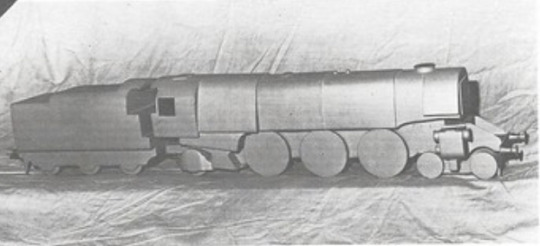
Ahhhh Proposed Bulleid Q1 Pacific my beloved…
Oh how I wish you were real in all your trapezoid glory…
It’s too bad I can’t insert you into any sort of thing ever, like yet another ttte au that’s different from the one I’ve got…
Unless…
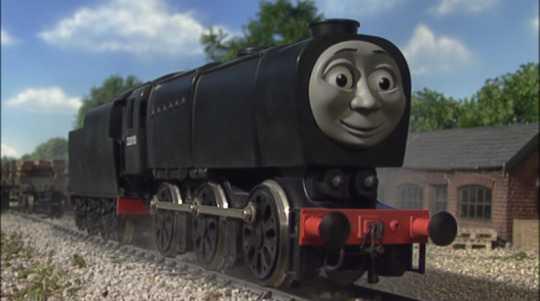
Why Hello Neville!
#ttte#ttte neville#ttte au#i have too much power#reality is whatever I deem it to be in MY universe#lol#honestly there are so many proposed/never built designs that are just great#And Bulleid’s proposed designs are a spectacle#Oliver Bulleid#southern railway
23 notes
·
View notes
Text
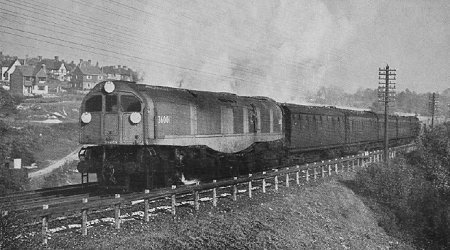
The Leader was a class of experimental 0-6-0+0-6-0 articulated steam locomotive, produced in the United Kingdom to the design of the innovative engineer Oliver Bulleid. The Leader was an attempt to extend the life of steam traction by eliminating many of the operational drawbacks associated with existing steam locomotives. It was intended as a replacement for the ageing fleet of M7 class tank engines still in operation on the Southern Railway (SR). Design work began in 1946 and development continued after the nationalisation of the railways in 1948, under the auspices of British Railways. The design incorporated many novel features, such as the use of thermic siphons, bogies and cabs at each end of the locomotive, resulting in its unique—for a steam locomotive—modern diesel-like appearance. Several of its innovations proved to be unsuccessful however, partly accounting for the project's cancellation in the early 1950s. Five Leader locomotives were begun, although only one was completed, No. 36001, The operational locomotive was trialled on the former Southern Railway network around Brighton. None of these engines survive today, but don't get your hopes up about a new build leader, I rarely ever say this, but I don't think this design should be brought back from the dead; it had so many problems that even with our modern technology probably couldn't rectify them and crew and passenger accounts state that the Leader was uncomfortable and somewhat an eye sore.
#train#trains#locomotive#steam locomotive#failed experiment#experimental#Oliver Bulleid#british railways#southern railways
21 notes
·
View notes
Text
And RAF Tangmere got a steam loco named after it. In the form of a Southern Railway Battle Of Britain Class of Light Pacific designed by Oliver Bulleid. One of the few examples that wasn't completely rebuilt. 20 locos are preserved and it's a mixture of rebuilt and unrebuilt locos like 34067 which was completed in 1947 and was in service until 1963 until sent to Woodham's scrapyard in Barry, South Wales in 1965 and bought for preservation in 1981. Woodhams scrapyard played a crucial role for the UK's preservation movement with so many locos coming from their and being restored and ran on the mainline or on heritage lines.


Pilots of 65 Squadron standing by Spitfire YT-O (P 7856) at Tangmere, Britain in 1941
➤SPITFIRE VIDEO: https://youtu.be/mtWwWt2LK8g
➤BRITISH AIRCRAFT VIDEOS: https://dronescapes.video/British
95 notes
·
View notes
Video
SR Bulleid Westcountry 34046 "Braunton" running as Battle of Britain 34052 "Lord Dowding" Corfe Castle 2/4/17 by TG37401 Via Flickr: SR Bullied Westcountry 34046 "Braunton" running as Battle of Britain 34052 "Lord Dowding"
#Southern Railway#SR#Oliver Bulleid#Oliver Vaughan Snell Bulleid#OVS Bulleid#Bulleid#Rebuilt#Westcountry Westcountry 34046 Braunton 34052 Lord#Dowding#Fuji#Finepix
7 notes
·
View notes
Text
Standard Steam Round 1 Match 5
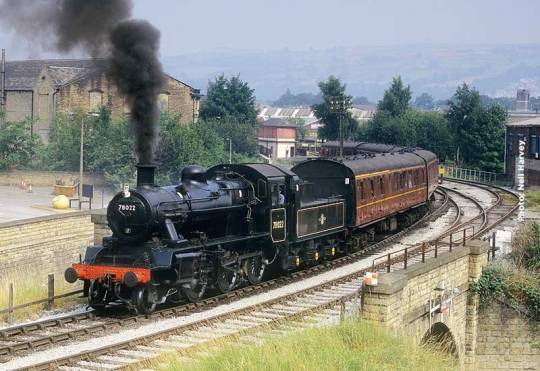
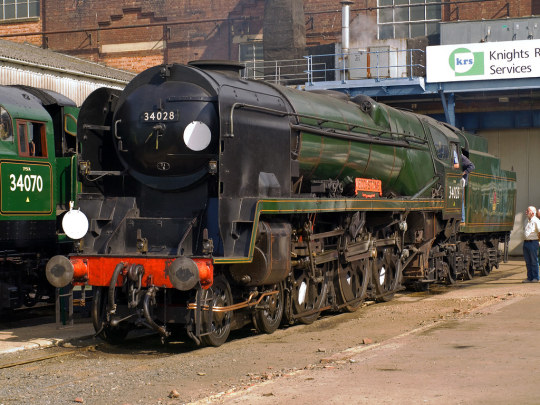
more details under cut :D
The class 2 were the smallest standard locomotives produced. they were heavily based on the lms class 2 but with a smaller loading gauge, they could be used almost anywhere. These engines gained a reputation as being "sure footed" and 4 still exist today.
The BR rebuilds of the light pacifics were a bonkers thing to do. The light pacifics started life with a chain driven valve gear and air smoothed casing designed by oliver bulleid. In the 1950s, british rail was working to a plan that saw a gradual phasing out of steam traction in favour of network-wide electrification that required steam locomotives to still be in use in the 1990s. As such they ordered a rebuild to remove the hard to maintain features on these locomotives. Not all light pacifics were rebuilt by the time they were withdrawn however.
5 notes
·
View notes
Text
So, after being reminded of the insanity that is Oliver Bulleid's Leader Class, and by extension some of the stranger aspects of Bulleid's engines in general, I have spiraled off into thinking of a new headcanon / additional bit of characterization for Rebecca.
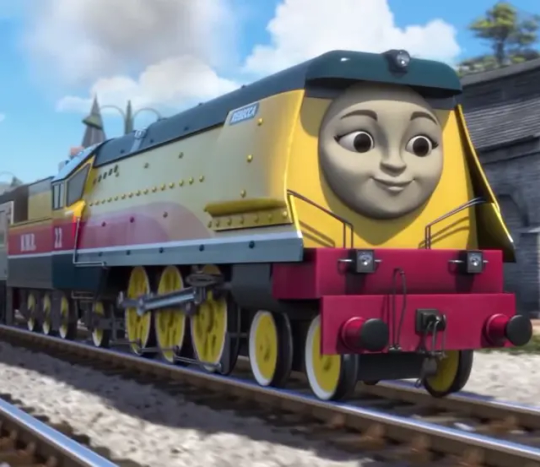
For anyone who doesn't know, Oliver Bullied was the Chief Mechanical Engineer for the Southern Railway starting in 1937, and is partially known for several of his designs featuring some unorthodox features, most notably his use of chain driven valve gear.
Rebecca is a Bulleid Light Pacific, so I feel it would fit to take some inspiration from the previous information about her builder, appropriately turned up to 11 for comedic effect and to fit the overall tone of the BWBA seasons of TTTE.
Consider:
Rebecca as a massive nerd / tinkerer / mad scientist of an engine, who is constantly experimenting with silly, outside the box, and very overly complicated solutions to problems, as well as just trying out various dumb ideas for the hell of it.
She notices her brakes are beginning to wear out and decided to try and extend the time before she has to get them fixed by instead stopping by throwing her wheels into reverse.
Pro: Less damage to brakes
Con: More damage to... everything else.
She hears about how the Skarloey Railway used to run gravity trains and decides to see how far the troublesome trucks can go on their own if released from the top of Gordon's Hill...
On the mainline...
Without telling anyone...
Maybe she spends a lot of time hanging around the Dieselworks of all places, because she's endlessly fascinated by the jury-rigged and patchwork repairs that have been made over the years to the work's equipment.
Den and Dart are confused by this, but feel very honored when Rebecca calls then "resourceful" and "innovative" for how they have kept the Dieselworks running.
There's even some support for this characterization in canon.
Rebecca is shown to be fascinated by the unique features of Harvey, Marion, and Belle in the episode What Rebecca Does and wishes she had something unique for herself.
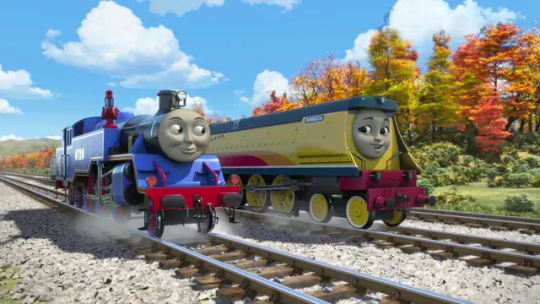
She seems to have an appreciation for unusual designs built to solve specific problems and do special tasks.
Then there's this quote from Rebecca's introductory scene in the episode Confusion Without Delay:
“Hello, sir. And, uh, sorry, sir. I miscalculated how long it would take me to stop…by, uh, quite a lot!”

The use of "miscalculated" feels like it fits with what I've laid out so far, like she actually tried to do the math in her head to come to a precise stop and it just didn't work out.
Now, is all of this very silly and a bit dumb? Yes
But is it funny? Also yes
Not only that, but there's honestly some pretty good story potential here.
Like, what if there was an episode with Rebecca and Duck?

There could be a conflict between Ducks adherence to the tried-and-true and very practical Great Western Way, and Rebecca's desire to always think outside the box and try something new.
And Rebecca's trying to be respectful of and go along with Ducks way of doing things, but frankly she just keeps getting bored and ends up inevitably distracted with trying out he own new ideas.
Most of them don't work, and fail in comedic fashion.
But one of Rebecca's ideas actually looks like it could succeed...
Until Duck, but now tired of the delays to his work, interrupts and unintentionally causes the whole thing to fall apart.
The eventual resolution to this story could then come in the form of the Slip Coaches being brought into the mix.
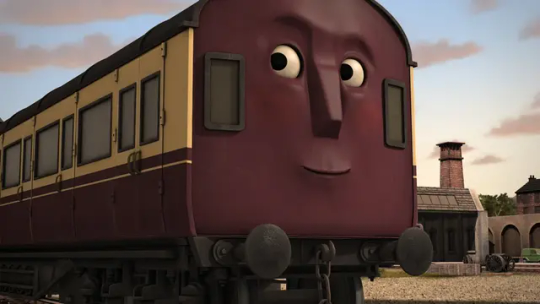
The Slip Coaches, who are a product of the Great Western Railway, and yet are also an example of a seemingly strange and outside the box idea, which proved to be successful when given the chance.
The story could then conclude with the moral of how some ideas that seem stupid might just need a bit of extra time and patience to develop and refine them into a practical application.
51 notes
·
View notes
Photo
OLIVER BULLEID MENTIONED!!!!



Bulleid/Raworth Co-Co Electric Locomotive
85 notes
·
View notes
Photo




1.- POV: You're Duck and that motherfuck behind Gordon has been talking shit about you. 2.- I headcanon these two as besties 3.- They're like Applejack and Rainbow Dash, NGL 4.- All of them are Oliver Bulleid designed locomotives
2 notes
·
View notes
Note
Have any thoughts on Dennis? (fair warning: I'm already getting a little obsessed with him, and if your answer is *too* good I might nick your ideas for Ex-Condor. you know. with credit. respectfully!)

Behold, a unit.
I honestly hadn’t until this ask of yours! But now I wanna give it my all. So, here goes!
I’m just gonna start off by saying it’s wrong of Dennis to carry the number 11001. For the rest of this post, just ignore it, and assume he’s “11002.”
In 1949, Ashford Works outshopped two diesel-mechanical locomotives, which became British Railways’ 11001 and 11002. They had been designed by the famous (and in many circles, infamous) Oliver Bulleid of the former Southern Railway. By 1949, Bulleid was in hot water with the young British Railways and the public in general for his reputation as a spendthrift who got his imagined locomotives built by dubious means. His Pacifics had been built during the war under the notion they could be mixed-traffic, (this was VERY untrue,) and his ongoing “Leader” development scheme was riddled with teething problems, all of which were built to the taxpayer after nationalization. It was under this cloud of scandal that 11001 and 11002 entered service.
The two unnamed brothers lived primarily at Norwood Shed, south of London. If they were to have further siblings built, they were intended for shunting duties and slow freight trains, undoubtably replacing tank engines in this current niche. Historians have failed to agree, but ‘01 and ‘02 are likely the first diesel locomotives built for British Railways, main line or otherwise. No further examples were built, however.
Growing up at the turn of the Fifties, ‘01 and ‘02 would have been absolutely surrounded by steam engines, who found them more amusing than a threat to themselves. British Railways was still running at a surplus, and there were plans for hundreds of steam engines of their own designs to be built in the coming years. Therefore, ‘01 and ‘02 were tolerated and even befriended by their steam coworkers. That would change, harshly.
January 1955. Word had gotten around among engines about a White Paper put together by the Government a month earlier. British Railways’ small profits at the beginning of the decade were gone. The company was now running at a deficit, costing more to run than what money it generated. The Government decided that to reverse this deficit by 1962, it would enact what it called its ‘Modernization Plan.’ The plan called for massive investments into the railway network and its rolling stock, to improve their competitiveness against the roads and win back lost clientele. This involved, among several other proposals, the wholesale replacement of steam engines with diesels and several main lines being electrified.
All eyes fell now on ‘01 and ‘02. They didn’t have a single steam friend in their corner now, and were treated not as friends but as enemies who had snuck in years earlier with this plan in mind the whole time. This obviously wasn’t true, but the steam engines were paranoid and powerless to stop what the company planned to do. The only course of action left, according to many steam engines, was to take this out on the diesels themselves. Other diesels in turn reacted by taking on an air of superiority and inevitable power against the outdated kettles they were now proud to replace. It can thus be said that the first real animosity between Steam and Diesel was in early 1955. ‘01 and ‘02 were in the thick of it all as it unfolded.
The two brothers, rather than join those diesels who decided to begrudge the steam engines in return, took no sides, instead becoming self-isolated and co-dependent on one another. This made any separation of the two terribly uncomfortable for both, and eventually led to them being bullied by fellow diesels as insufficiently hateful of steam engines.
By August 1959, ‘01 was out of service with a failed gearbox. ‘02 was still mechanically sound, having been used less, but was absolutely shattered by the loneliness of his brother being off the road. 1960 couldn’t have been grimmer for ‘02, when he learned ‘01 had been scrapped on New Year’s Eve at Ashford, and he himself didn’t have much time. As a non-standard engine, with scores of new diesel locomotives on the way, he was to be taken out of service as soon as could be arranged.
For a few months, ‘02 lingered in the Out of Use sidings at Ashford Works, surrounded by withdrawn steam engine also awaiting their demise and thrilled at the opportunity to mock a diesel for joining them on the way to the chopping block. To their shock, the Controller of the North Western Region, Sir Bertram Topham Hatt I, had turned up on a visit of inspection. He was searching for a small, slow engine to shunt his works at Crovan’s Gate. As ‘02 fit that bill, and was in need of little repair and historically significant, he was chosen. Bertram was at this time hoping to pad out his stock with older, now-endangered diesel engines as their times on the Mainland came up, and ‘02 was saved to the steam engines’ fury.
‘02, who took the name Dennis after his first driver on Sodor, began his new lease on life uncomfortably. He was surrounded by steam engines, which put him on edge enough, not to mention that several such as James were also hostile to diesels. This discomfort led to a few unfortunate mishaps, and the Works Foreman put Hatt on notice to find another engine for the job. Hatt naturally wouldn’t scrap Dennis, and searched high and low for a new line of work that could fit him.
It didn’t take long, and what he settled on suited Dennis to a tee. The Permanent Way Department had for a few years now wanted a diesel engine to run their trains for them. A diesel would be far better suited to long periods of waiting, and being able to start and stop at a moment’s notice. The job was more ideal still for Dennis in that it didn’t require an engine with train braking equipment. Dennis didn’t have this, and it was doubtful if another job with this same non-requirement would turn up soon. So, he was soon assigned to this.
Dennis came to relish the work, most of all because the workmen treated him as their own engine, not as a steam engine, nor even as an efficient diesel engine, but as Dennis. Some engines resent his new lease on life as dawdling between stations with the track gangs, but despite his reputation for it, Dennis is anything but “lazy.” He found a steady job, he found crews who appreciate what he does for them, and if it means sitting in station loops until it’s time to move, that’s not a rest, it’s legitimately part of his job. The resting’s just a small perk, so leave him be, eh?~
25 notes
·
View notes